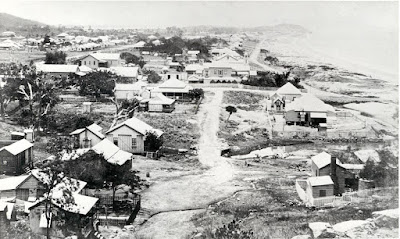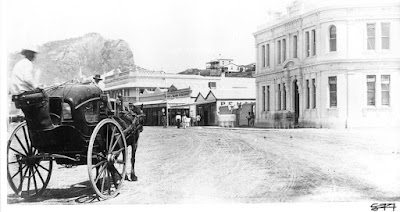This year James Cook University celebrates its proud legacy in historical research, writing and publishing through the Studies in North Queensland History Collection. In partnership with the JCU College of Arts, Society and Education (CASE), the Library has made available online, free digital versions of a selection of diverse works – both published books and unpublished theses all originating from the JCU History Department. To complement this showcase a new series of blog posts provide a fresh response to each work through the contemporary lens of a prominent practicing historian. In today’s post, Dr Lyndon Megarrity (James Cook University) writes about Gateway to a Golden Land: Townsville to 1884 by Dorothy M. Gibson-Wilde, published in 1984 by the JCU History Department.
For most of its history, the port city of Townsville has been the largest population centre in Northern Australia and has often been described as the unofficial capital of North Queensland. Ironically, Townsville’s role as a major regional centre remains barely acknowledged by Australian historians. Furthermore, even in the late twentieth century, the historical information available to the public on Townsville’s establishment and development was severely limited and occasionally inaccurate in its coverage of local events, themes and milestones.
Dr Dorothy M. Gibson-Wilde OAM (1935-2021), author, historian and heritage consultant, had a strong interest in Townsville’s early history, and over her long career, she stressed the importance of preserving the city’s built heritage and worked to gain wider public awareness of its rich past. Sometimes in collaboration with her husband Bruce, Dorothy published several books on Townsville’s history.
 |
| Castle Hill viewed from Melton Hill c.1888, NQID 4739, Townsville Albums, NQ Photographic Collection, JCU Library Special Collections. |
Released in 1984, Gateway to a Golden Land is probably her best known book. It was an especially significant publication, because it was the first published academic account of Townsville’s establishment and early development between 1864 and 1884. The publication was based on Gibson-Wilde’s BA (Hons) thesis, supervised by Professor Brian Dalton, the head of the History Department at James Cook University (JCU). With Dalton’s active support, the thesis was swiftly converted into a book and published internally by the Department of History: using the facilities of the JCU printery, Dalton had for some years been publishing books on North Queensland history based on research conducted by JCU history staff and students.
Gateway to a Golden Land tells the story of a town that thrived because Townsville was in the right geographical location to provide services to the sugar, pastoral and mining industries which developed in North Queensland. Despite natural disasters, industry downturns and the competition from subsequent port towns such as Cairns, the rapid diversification of Townsville’s economy and its proximity to nearby goldfields such as Charters Towers and Ravenswood ultimately made the town a major cultural, political and economic hub.
The author offers a comprehensive study of the development of Townsville as an urban landscape, with a strong emphasis on the evolution of the town’s built environment and the rapid growth in social and civic amenities. Gibson-Wilde finds much to praise in the pioneering efforts of early European settlers, although she acknowledges the displacement by Europeans of Aboriginal people and damage to the surrounding environment as Townsville grew and expanded.
One of the great strengths of the book is its meticulous research. Gibson-Wilde overcame the relative lack of easily available material in a number of ways. Townsville newspapers were either lost or non-existent for some of the period under review, but the author found much information on Townsville in contemporary newspapers such as the Port Denison Times and the Queenslander. Further, while researching in Rockhampton, Gibson-Wilde fortuitously discovered bound copies of Townsville’s early periodical, the Cleveland Bay Express. Aside from consulting government sources, contemporary printed books and secondary sources, the author found correspondence and diaries in the Mitchell Library (Sydney) and the John Oxley Library (Brisbane) which shed light on the experiences of Europeans living and working in an isolated frontier townscape.
 |
| Carter St, North Ward and the Strand, c. 1889, NQID 282, Ron Mackenzie Album, NQ Photographic Collection, JCU Library Special Collections. |
Held in the Mitchell Library, the correspondence of the co-founders of Townsville, John Melton Black and Sydney merchant Robert Towns, was used by the author to highlight the reasons for the town’s establishment. A great incentive for creating the new town was Towns’ considerable property holdings in what became the wider Townsville region and hinterland. These properties had been previously owned by Black and transferred to the Sydney merchant as part of a business agreement between the two entrepreneurs. Towns’ financial backing and input is clearly revealed, but the author convincingly shows that Black as the managing partner of Black & Co. was the major driving force behind the town’s establishment and early growth.
 |
| Bank of New South Wales, corner of Flinders and Wickham Streets, NQID 264, C.J. Allom & A.R. Bailey Album, NQ Photographic Collection, JCU Library Special Collections. |
Another rich Mitchell Library source was the diary of the first bank manager of the Townsville branch of the Bank of New South Wales, James Thomas Walker, who provided first-hand descriptions of Townsville in 1866: ‘a picturesque spot with a fine bold hill in its rear known as Castle Hill – the Town is not much at present’ (p. 68). In contrast, an early visitor to Townsville, Lucy Gray, admired its ‘wide bay with mountains [of] every shade of blue violet gray stretching away to the north … suggesting an infinity of lovely places’ (p. 87).
Gateway to a Golden Land remains a vital reference work which will continue to be consulted by historians interested in Townsville’s social, economic and cultural development during its first two decades.1
Dr Lyndon Megarrity, James Cook University
1 It should be noted that there were two BA (Hons) students who completed theses on the early history of Townsville in the early 1980s at JCU: Gibson-Wilde and Helga M. Griffin. Griffin’s thesis covered the same period as Gibson-Wilde, and necessarily discussed many of the same themes and issues. However, the authors offered different perspectives on the topic. Griffin’s study was notable for its extensive use of statistics and her emphasis on social issues such as Aboriginal-European relations. Gibson-Wilde stressed the development of infrastructure and facilities, with a special focus on the district’s buildings such as hotels and private housing. Geoff Hansen’s North Queensland History Preservation Society subsequently published Griffin’s thesis in 2014 as Frontier Town: A History of Early Townsville and Hinterland 1864-1984.
Further Reading:
Gibson-Wilde, Dorothy M., Gateway to a Golden Land: Townsville to 1884, James Cook University, Townsville, 1984.
Gibson-Wilde, Dorothy Mary, ‘Gateway to a Golden Land: Townsville to 1884’, BA (Hons) thesis, James Cook University of North Queensland, 1982.
Griffin, Helga, ‘Frontier Town : The Early History of Townsville and its Hinterland, 1864-1884’, BA (Hons) thesis, James Cook University of North Queensland 1983.
Griffin, Helga, Frontier Town : A History of Early Townsville and Hinterland 1864-1884, North Queensland History Preservation Society, Townsville, 2014.
Hansen, Geoffrey E.P., Megarrity, Lyndon, and Menghetti, Diane, Goldfields that Made Townsville, Townsville Museum & Historical Society, Townsville, 2018.


Comments